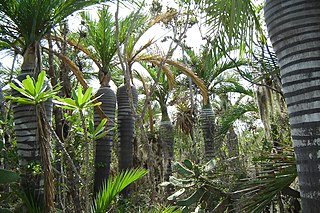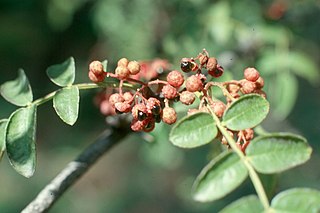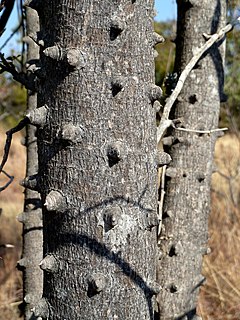
The Rutaceae is a family, commonly known as the rue or citrus family, of flowering plants, usually placed in the order Sapindales.

Zanthoxylum is a genus of about 250 species of deciduous and evergreen trees, shrubs and climbers in the family Rutaceae that are native to warm temperate and subtropical areas worldwide. It is the type genus of the tribe Zanthoxyleae in the subfamily Rutoideae. Several of the species have yellow heartwood, to which their generic name alludes.

Pseudophoenix ekmanii is a palm species endemic to the Barahona Peninsula and Isla Beata in the Dominican Republic. It is a small tree, four to six metres tall, with pinnately compound leaves and solitary, swollen stems. The fruit are reddish with a diameter of about 2 centimetres in diameter.
Thomas Gordon Hartley was an American botanist.
Neea ekmanii is a species of plant in the Nyctaginaceae family. It is endemic to Cuba. It is threatened by habitat loss.

Coccothrinax ekmanii (gwenn) is a palm which is endemic to the island of Hispaniola.

Copernicia ekmanii is a palm which is endemic to northern Haiti.

Zanthoxylum brachyacanthum, known as thorny yellow-wood, satinwood, satin tree or scrub mulga, is a species of flowering plant in the family Rutaceae and is endemic to north-eastern Australia. It is a rainforest shrub or tree with thick, cone-shaped spines on the trunk and prickles on the branches, pinnate leaves, and male and female flowers arranged in panicles.

Zanthoxylum americanum, the common prickly-ash, common pricklyash, common prickly ash or northern prickly-ash, is an aromatic shrub or small tree native to central and eastern portions of the United States and Canada. It is the northernmost New World species in the citrus family, Rutaceae, and is the type species in its genus, which includes sichuan pepper. It can grow to 10 meters (33 ft) tall with a diameter at breast height (DBH) of 15 cm (5.9 in). It produces membranous leaflets and axillary flower clusters. The wood is not commercially valuable, but oil extracts from the bark have been used in traditional and alternative medicine, and have been studied for antifungal and cytotoxic properties. The genus name is sometimes spelled Xanthoxylum.
Dennisiella is a genus of fungi in the family Coccodiniaceae. It has 9 species. The genus was circumscribed by mycologists Augusto Chaves Batista and Raffaele Ciferri in 1962, with Dennisiella babingtonii designated as the type species. The generic name honours British mycologist R. W. G. Dennis. Fungi in this genus are epifoliar; that is, they live on living plant surfaces, particularly leaves.

Zanthoxylum asiaticum is a species of plant in the family Rutaceae. Under its synonym Toddalia asiatica, it was the only species in the monotypic genus Toddalia, now included in Zanthoxylum. It is known by the English name orange climber.

Zanthoxylum armatum, also commonly called winged prickly ash in English, is a species of plant in the family Rutaceae. It is an aromatic, deciduous, spiny shrub growing to 3.5 metres (11 ft) in height, endemic from Pakistan across to Southeast Asia and up to Korea and Japan. It is a source of the spice Sichuan pepper, and also used in folk medicine, essential oil production and as an ornamental garden plant.

Zanthoxylum capense, the small knobwood, is a species of plant in the family Rutaceae. It occurs in the eastern regions of southern Africa, from the vicinity of Knysna, Western Cape to the Zimbabwean granite shield and coastal Mozambique. It tolerates a range of altitudes, from highveld to coastal elevations, but is most prevalent in dry thickets or on rocky slopes and outcrops.

Zanthoxylum nitidum, commonly known as shiny-leaf prickly-ash, tez-mui or liang mian zhen, is a species of flowering plant in the family Rutaceae. It is a woody climber with prickles on the branchlets, thick, cone-shaped spines on the trunk and older branches, pinnate leaves with five to nine leaflets, and panicles or racemes of white to pale yellow, male or female flowers in leaf axils and on the ends of branchlets.
Cinnamodendron ekmanii is a species of flowering plant in the family Canellaceae. It is found in the Dominican Republic.

Sichuan pepper, also known as Szechuan pepper, Szechwan pepper, Chinese prickly ash, Chinese pepper, Timut pepper, rattan pepper, Dolná Seč and malapepper, is a spice commonly used in the Sichuan cuisine of China's southwestern Sichuan Province. When eaten it produces a tingling, numbing effect due to the presence of hydroxy-alpha sanshool in the peppercorn. The spice has the effect of transforming other flavors tasted together or shortly after. It is commonly used in Sichuan dishes such as mapo doufu and Chongqing hot pot, and is often added together with chili peppers to create a flavor known as málà.

Zanthoxylum rhetsa, commonly known as Indian prickly ash, is a species of flowering plant in the family Rutaceae and occurs from India east to the Philippines and south to northern Australia. It is a deciduous shrub or tree with cone-shaped spines on the stems, pinnate leaves with between nine and twenty-three leaflets, panicles of white or yellowish, male and female flowers, followed by spherical red, brown or black follicles.
Casasia ekmanii is a plant belonging to the family Rubiaceae, it is native to Haiti.
Zanthoxylum austrosinense, or South Chinese Sichuan pepper, is a woody plant in the family Rutaceae and is native to southern China.












